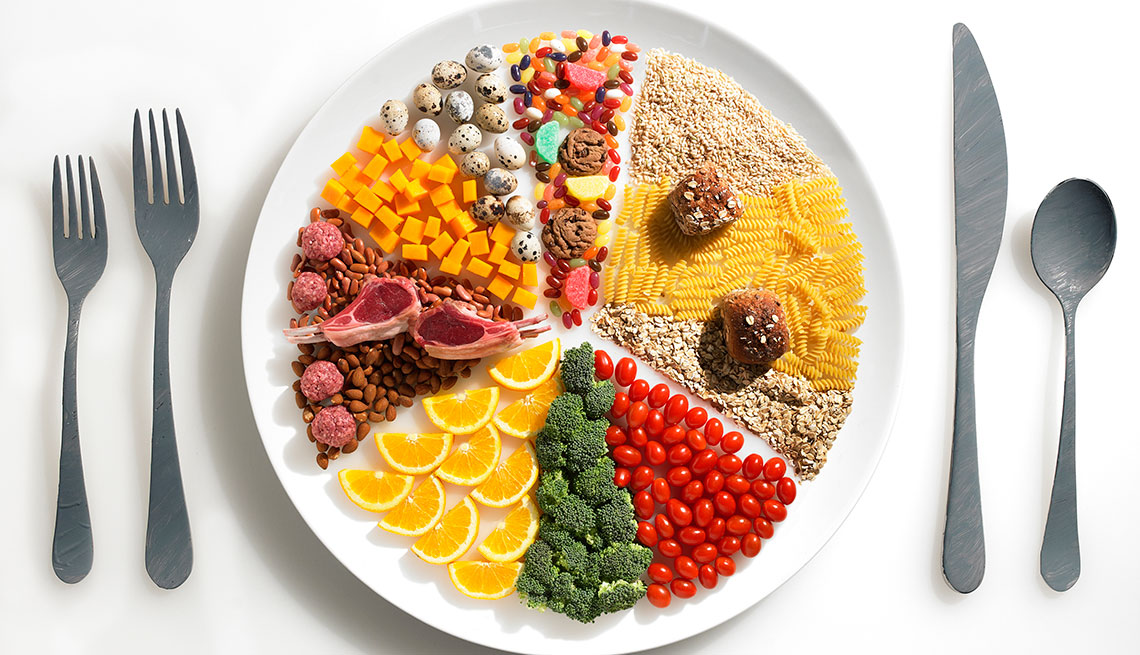
How to create a balanced meal of healthy food to eat
- Select a language for the TTS:
- UK English Female
- UK English Male
- US English Female
- US English Male
- Australian Female
- Australian Male
- Language selected: (auto detect) - EN
Play all audios:

Using the U.S. Department of Agriculture’s revamped food pyramid, MyPlate. 1. Picture the plate divided into quarters. 2. Cover most of a half with cooked or raw, high- fiber, colorful and
dark green vegetables, leaving enough space for a healthy serving of fruit. Five servings a day reduces the risk of heart disease and stroke. Fiber slows digestion and prevents blood sugar
spikes. 3. Fill a scant quarter of the plate with lean protein, as wide and thick as a deck of cards. Fish, poultry, meats, tofu, eggs, nuts and nut butters provide the nutrients needed to
build and repair cells, deliver energy, and help create enzymes, hormones and antibodies. Serve fish twice a week. 4. The last — slightly larger — quarter-plate is for whole grains, such as
barley, brown rice, 100 percent whole wheat or whole grain bread, oatmeal, quinoa and beans with brown rice. (Double win: Quinoa and beans with brown rice form a whole protein when eaten in
the same day and can be counted as either grain or protein.) Low glycemic, complex carbs provide energy without spiking blood sugar and help reduce insulin resistance and the risk of
cardiovascular disease. 5. Healthy polyunsaturated and monounsaturated fats, such as those found in fatty fish, nuts and seeds, avocados and olive oil, should be an everyday thing. The
recommended range is 3-6 teaspoons. The USDA advises that fat account for between 20 and 35 percent of total calories eaten. Less than 10 percent should be saturated—7 percent for those with
high LDL cholesterol. SOURCES OF GOOD OILS: * Olive * Safflower * Avocado * Canola * Fish oil * Nuts For flavor, use a dash of walnut or sesame oil. UNHEALTHY FATS INCLUDE: * Animal fat *
Cheese * Butter * Lard * Stick and tub margarines * Shortening * Partially hydrogenated oils/trans fats IS COCONUT OIL GOOD OR BAD? There have been no long-term studies of how coconut oil
affects human cholesterol levels. The American Heart Association recommends holding off on coconut oil because it contains saturated fat, which shouldn’t exceed 13 grams — about a tablespoon
— a day. STEP 3. INCLUDE CALCIUM Serve meal with low-fat milk, no-sugar-added yogurt, kefir, cheese or other dairy product. If your loved one cannot eat dairy, include high-calcium veggies
like kale and broccoli, and ask the doctor about adding a calcium supplement. STEP 4. MIX IT UP Once you’re familiar with portion size, likes and dislikes, you can mix it up. Add almonds to
green beans, fruit to salad, tzatziki to chicken, rice to black beans, green onions and apple to quinoa. To make a good meal great and add more nutrients, use spices, herbs, lemons, limes,
shallots and garlic. STEP 5. DON'T FORGET SOME SWEETS Celebrations and treats add sweetness to life. Look for recipes such as grilled peaches with pureed raspberries, and no-sugar-added
fruit pie with walnut crust, that let you and your loved one enjoy a reasonably healthy splurge.
